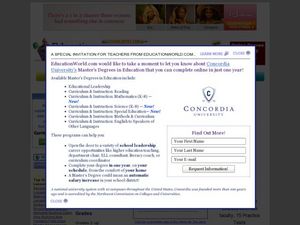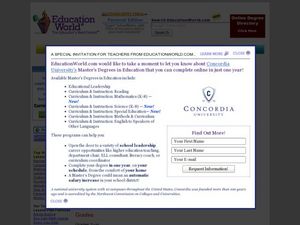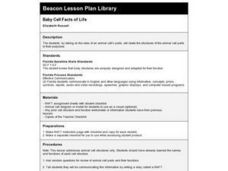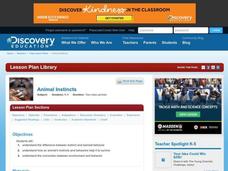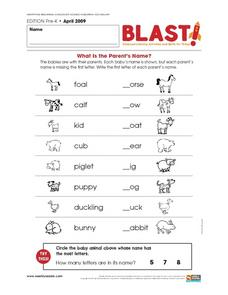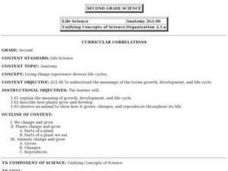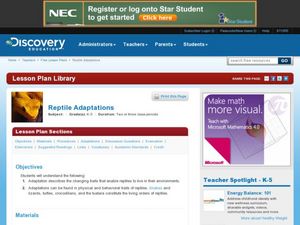Curated OER
Baby Elephant Orphans Get New Home, Families
Students react to a series of statements about elephants, then read a news article about how workers at an elephant orphanage are working to return the animals to the wild. In the animal studies and current events lesson, the teacher...
Curated OER
Parent and Baby Lookalikes
Students research baby animals, their special names and the vocabulary to describe their relative sizes through discussion, listening to a Salish story, looking at pictures, and creative artwork . They will also explore the significance...
Curated OER
Form and Observation
Use a familiar song and adorable baby animal pictures to teach youngsters about genetic variation. Begin by listening to "Twelve Variations on 'Ah vous dirai-je Maman,'" which you will need to find online (there are several versions...
Curated OER
Baby Animals Debut at Zoos
Students determine the names of animal babies, then read a news article about zoo's experiencing animal births. In this current events lesson, the teacher introduces the article with vocabulary activities, then students read the news...
Curated OER
Animals and Animal Babies
Students examine how some animal young are similar to the adult. They look at pictures of various animals and their young and identify if they look similar or not similar to the adult animal, and draw a picture of a baby and parent...
Curated OER
Baby Cell Facts of Life
Students examine the roles of an animal cell's parts, how each part relates to one another and then demonstrate their knowledge by writing a story about the animal cell structure.
Curated OER
Family Lesson Plan
Kindergarteners discuss families with this resource. They talk about human families, explaining how they grow and change, and focus on vocabulary words. Then, they talk about animal families, discuss the vocabulary involved, and match...
Curated OER
My Owl Babies Miss Momma
Students investigate the relationship between children and parents by reading a book about owls. In this story analysis lesson plan, students read the book Owl Babies and participate in a role play based on one of the characters....
Curated OER
Animal Instincts
Students compare animal adaptations to human behavior. In this science lesson, students discuss animal instincts vs. learned behavior. Options for student writing, drawing and research are incorporated into this lesson plan
Curated OER
Growing Up
Here is a sweet lesson that will help your young learners think of themselves in a new light. They compare themselves to babies, and brainstorm all of the ways that they are different from babies. They make a list of things they can do...
Curated OER
Help the Duck Find Her Babies
Young scholars are introduced to a basic characteristic and need of living things-the ability and need to reproduce. They investigate how birds (and people) attract mates. Students discover how to build a nest. They discuss the needs and...
Curated OER
Chips Ahoy: Chip Off the Old Block
First graders compare and contrast adult and baby animals to identify similar characteristics shared by both.
Curated OER
What is the Parent's Name?
In this early childhood word recognition worksheet, students read the 8 baby animal's names and fill in the blanks of the matching adult animal's names with the correct letter.
Curated OER
Farm Babies
Pupils use flash cards to match the mother names to the baby names for farm animals. In a designated "barn" in the room, students simulate being mothers, fathers, and babies. The baby must find his mother and father. Pupils visit a...
Curated OER
Animal Babies on the Farm
Students identify different farm animals and match farm animal babies to their parent(s). They recognize more specific gender terminology for farm animals.
Curated OER
Baby Animals
Students study baby penguins and whales. They name the penguin body parts and examine how penguins hatch from eggs. They name whale body parts and their function. They participate in a whale role play activity.
Curated OER
Life Cycles: A Never-Ending Story
Second graders describe the sequence of events in the life cycles of a butterfly, frog, and a deer. They observe the differences and similarities of parents and babies. They also discover that at different stages the animals can be...
Curated OER
Animals and Environments
Students listen to stories and identify animals and their young. In this animals lesson, students view videos about farm animals and create illustrations to show how animal babies change over time. Students discuss...
Curated OER
Help the Duck Find Her Babies
Students study the basic need for animals to attract mates and reproduce young.
Curated OER
A Prickle of Hedgehogs
Pupils, individually or in groups, conduct research to find information needed to complete a worksheet in which they must match an animal name with 1) the name of its offspring (dog-puppy) and 2) its animal group name (geese-gaggle.)
Curated OER
Living Things Experience Diverse Life Cycles
Second graders will study and explain the meaning of growth, development, and life cycle. They describe how plants grow and develop and observe an animal to show how it grows, changes, and reproduces throughout its life.
Curated OER
Reptile Adaptations
Pupils research animal adaptations. For this adaptations lesson, students research the physical and behavioral adaptations of animals. Pupils create a diagram of their animal labeling it's adaptations.
Curated OER
Farm Animals - Mothers and Babies - "Are You My Baby?"
Students listen to a teacher read aloud and discuss the farm animals. They participate in an role playing activity that explains how mother mammals recognize their young by their scent.
Curated OER
Robin To the Rescue
For this animal care worksheet, students learn the proper steps to take if they ever see a baby bird on the ground. Students read the informative paragraph and solve an easy maze about birds.
